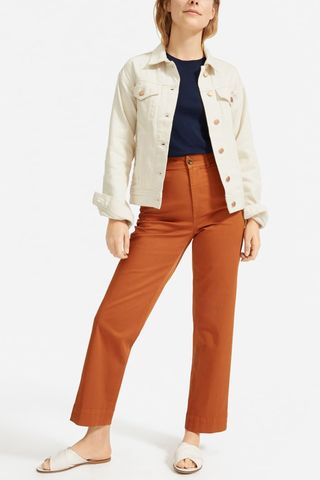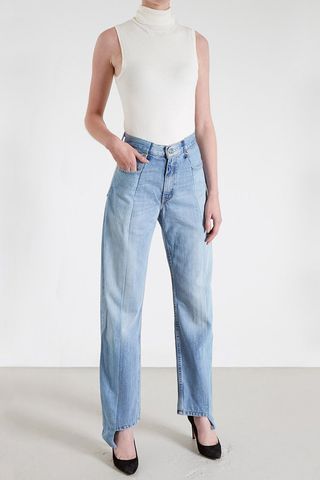It can take up to 1,800 liters of water to produce a single pair of jeans. To give you an idea of what that looks like, it’s equal to flushing your toilet 132 times in a row. And that’s not the only problem the denim industry has. The EPA reported that between 1960 and 2015, textile waste has increased by 811 percent. According to a Greepeace report, approximately 1.7 million tons of chemicals go into producing two billion pairs of jeans every year. It’s a little bit scary.
Thankfully, shoppers are more aware than ever before, and the new wave of denim brands are challenging traditional practices of waste. “If you start by considering the impact these brands have on the world, it helps to narrow the scope a bit,” said Michelle Marsh, the sales director of sustainable denim brand Ética. She raises the questions we should all be asking to be more conscious consumers: “Where are they being produced? How are their workers treated? Do they make a living wage? How much water and energy are they wasting throughout the production process? Are they using harsh chemicals to create their washes? What kind of waste are they leaving behind?”
Below, we took a closer look at how three brands—Mavi Jeans, Everlane and Ética Jeans—are answering those questions. Together, these cases provide insight into how different tiers of the industry are taking the steps toward a cleaner future.
Mavi Denim
Mavi Jeans pretty much introduced the world to designer denim back in the early ’90s and peaked around the 2000s, when Avril Lavigne ruled the world. (She was, of course, a big fan of their jeans.) Everyone had a pair of bootcut Mavis. The brand was founded by Sait Akarlılar in 1991, but its ties to denim manufacturing go back even further. Akarlilar also owns ERAK, a Turkish facility that has been making denim for brands worldwide since the ’80s. As part of the OG denim industry, Mavi existed long before the “trend” toward sustainability came along. With over 25 years in the business, they’re constantly updating their factories to keep up with consumer demands for a more responsible business model.
Stonewashed denim, whiskered textures, and other denim treatments do not come without the pricetag. These details waste massive amounts of water, energy, and labor when done in the traditional manner, but Mavi significantly cut these processes down. For example, the company uses actual lasers to burn whiskers into their fabric, significantly cutting back on water waste. “We used 62% less water and 28% less energy year on year,” their PR team said about their growth from 2018 to 2019, with plans to continually improve.
In 2020, Mavi is rolling out global initiatives to launch a “sustainable 100% vegan collection with no animal materials used in production,” pivoting their offices to a plastic-free environment, and are currently using only 100% recycled materials for packaging. Beyond sustainability, Mavi collaborates with the Ecological Research Society for their Indigo Turtles project, “to help protect endangered sea turtles native to the Mediterranean. In addition to active field work to help save the turtles, Mavi has designed exclusive t-shirts where the proceeds to go EKAD to further their research and mission.” The brand also sponsors their office workers to travel across Turkey to help newborn turtles reach the ocean. C’mon.
Everlane
Everlane has been in the sustainability game since its inception, with a brand mission dedicated to creating clothes compassionately made with the planet in mind. When they launched denim in 2017, the company wanted to make sure they reevaluated the entire operation. “Denim is a really dirty business and the biggest challenge was finding a factory that had zero impact on the environment,” said Kim Smith, the general manager of apparel at Everlane. “Denim production is a very water and chemical intensive and factories often release the dirty water and sludge into the ecosystem which is damaging to the environment. We knew we could do better.”
Pioneering sustainable policies across the field, Everlane pushes the boundaries of what can and can’t be done with large-scale production lines. They produce their denim in a clean factory named Saitex, which recycles 98% of their water, use Bluesign-approved chemicals, and air-dry their denim indoors. Yes, you read that last part right— their factory has rows of denim that hang above the factory floor and zip around to dry. Compared to the previously mentioned 132-toilet-flush jeans, a pair of Everlane jeans uses .4 liters, thanks to their closed water system and efficient washing machines. Side note: they also “turn the excess denim waste into bricks made for the homeless.”
Where do they go from here? “We are now looking further up our supply chain to focusing on finding sustainable mills and cotton farms,” Smith said. With open dialogue as a core value of their company, Everlane hopes that their brand of radical transparency empowers the people who wear their clothes. “We’re not only building trust with our customers, but we’re giving them the tools to make more informed choices.”
Ética Denim
When it comes to transparency, Ética Denim is an over-sharer. Their website thoroughly details their practices—complete with charts, PDF files, and hyperlinks to California state labor laws—to ensure their customers are armored with all the information they could possibly need. Based in Los Angeles, California, it represents slow fashion at its best.
Ética provides a sustainable collection that goes beyond the basics. From denim dyed with liquid indigo to reduce water waste, to turmeric jumpsuits made from vintage deadstock fabric, every step of their production line is intentional. “Sustainability requires innovation; our design and manufacturing teams work tirelessly to create vintage-inspired washes that are both authentic and eco-friendly,” said Michelle Marsh, the sales director of sustainable denim brand Ética. “We are all on a mission to put the best possible product out in the world while keeping our environmental impact to a minimum. “
Because the brand operates on a much smaller scale than Mavi and Everlane, they’re able “to react much faster to market feedback and advances in technology that help us to improve both our product and our processes every season.” Look to indie brands like Ética for super-responsive practices: They can provide certifications from independent organizations like SEDEX and the UN Global Comtact, who audit and certify factories to ensure they’re complying to just environmental and labor laws. “We believe that fashion and sustainability are not mutually exclusive. We can all do good while looking good.”
Thankfully, the market isn’t limited to these three brands only. Stella McCartney has always been a high-fashion designer with a focus on ethical practices, and other indie labels are devoted to decreasing their carbon footprints. “Denim is meant to last for years and years, and the most important thing customers can do is invest in a high-quality pair that will stand the test of time,” Martin says. Do your part, one mom jean at a time.


















